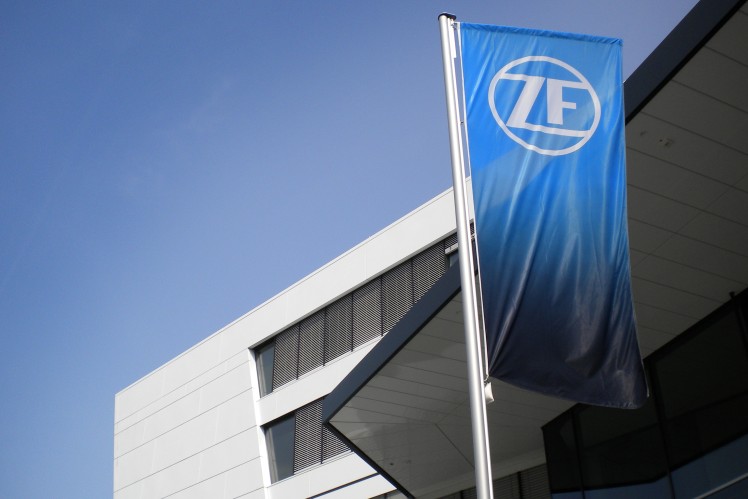Integrated Safety Systems: A Path to Achieve the Vision of Zero Accidents - Autonomous driving holds great potential for helping to reduce accidents
- ZF interconnects and integrates sensors, driver assist and occupant safety systems
- The systems currently available could help to significantly reduce the number of road fatalities if deployed worldwide.
Friedrichshafen. From a statistics perspective, about 90 percent of all accidents are caused by human error. This means that the human factor represents a significant potential accident risk on the roads. Experts agree that autonomous driving has the potential to help increase road traffic safety and reduce the number of traffic fatalities, which currently numbers at 1.25 million annually. That’s because automated vehicles are designed to not take unnecessary risks, go too fast or operate under the influence of alcohol, and they are not susceptible to human fatigue or emotions. Nevertheless, they are designed to move in traffic that will continue to be dominated by manually driven vehicles, which represent potential accident risks.

“The safety potential of autonomous vehicles can be achieved if all systems, such as sensors, driver assist and occupant safety systems are aligned with one another,” explains Torsten Gollewski, head of Advanced Engineering at ZF Friedrichshafen AG. “As one of the largest automotive suppliers worldwide with extensive expertise in driveline, chassis and active and passive safety technologies, not to mention our numerous strategic acquisitions and partnerships, we are well-positioned in all relevant sectors to achieve this.”
One challenge that will remain for the foreseeable future is the short time window that is available to sensors, sensor fusion and actuators to help definitively detect accident risks and respond as the situation requires. Working from current accident statistics, ZF experts have drawn up and analyzed an extensive catalog of scenarios for frontal and side collisions. They found that, in more than 60 percent of evaluated cases, the time before the accident at which a collision was inevitable was 500 ms. In certain scenarios, for example oncoming traffic with high relative speeds, that window shrinks to less than 300 ms. Therefore, vehicles must react within this time period for integrated safety systems to help at least to mitigate the effects of the impact on the vehicle occupants. To meet these highly complex challenges, ZF continues to develop rapid detection sensor technologies in a gradated, comprehensive sensor concept. Many European inner-city areas have developed organically over time. Sensors cannot always recognize these extremely complex road systems. ZF’s Car2X/5G activities aim to provide solutions designed to take control in accident scenarios even during the medium term.
We need innovative, integrated safety systems that help provide protection in unavoidable accidents. ZF is working hard on the right solutions. That includes further developing protection systems housed in alternative installation spaces, such as in the roof or the seats, and continually refining them to market maturity. On top of that, ZF is also developing new safety systems such as the center airbag ( https://www.zf.com/corporate/en_de/press/list/release/release_33473.html ).
This concept will help prevent the driver’s head from making extreme lateral movements and colliding with the head of the front seat passenger in the event of side impacts. The biggest challenge for occupant safety in automated-drive vehicles is flexible vehicle interior design, for example with moveable seats. This is a primary reason why ZF and interior specialist Faurecia announced their recent partnership on future cockpit designs with safety as a paramount goal.
Another important function for level 3 and 4 autonomous driving systems is a safe and definitive handover of control back to the driver from automated driving mode. “While occupants may enjoy more freedom of movement and activity in autonomous vehicles, we believe it is all the more important for the driver to be actively monitoring the situation in case he or she needs to intervene,” adds Gollewski. “Only if the designated vehicle driver is alert and ready to intervene can we return the job of driving to the human pilot.”
“Even if all the challenges that we face on the road to Vision Zero cannot be solved immediately, road users around the world will still benefit from our comprehensive expertise,” of that, Torsten Gollewski is sure. “Through our studies and analyses, the global launch of all driver assist systems that ZF provides could help to cut the number of road accident victims significantly.”
- Autonomous driving holds great potential for helping to reduce accidents
- ZF interconnects and integrates sensors, driver assist and occupant safety systems
- The systems currently available could help to significantly reduce the number of road fatalities if deployed worldwide.
Friedrichshafen. From a statistics perspective, about 90 percent of all accidents are caused by human error. This means that the human factor represents a significant potential accident risk on the roads. Experts agree that autonomous driving has the potential to help increase road traffic safety and reduce the number of traffic fatalities, which currently numbers at 1.25 million annually. That’s because automated vehicles are designed to not take unnecessary risks, go too fast or operate under the influence of alcohol, and they are not susceptible to human fatigue or emotions. Nevertheless, they are designed to move in traffic that will continue to be dominated by manually driven vehicles, which represent potential accident risks.

“The safety potential of autonomous vehicles can be achieved if all systems, such as sensors, driver assist and occupant safety systems are aligned with one another,” explains Torsten Gollewski, head of Advanced Engineering at ZF Friedrichshafen AG. “As one of the largest automotive suppliers worldwide with extensive expertise in driveline, chassis and active and passive safety technologies, not to mention our numerous strategic acquisitions and partnerships, we are well-positioned in all relevant sectors to achieve this.”
One challenge that will remain for the foreseeable future is the short time window that is available to sensors, sensor fusion and actuators to help definitively detect accident risks and respond as the situation requires. Working from current accident statistics, ZF experts have drawn up and analyzed an extensive catalog of scenarios for frontal and side collisions. They found that, in more than 60 percent of evaluated cases, the time before the accident at which a collision was inevitable was 500 ms. In certain scenarios, for example oncoming traffic with high relative speeds, that window shrinks to less than 300 ms. Therefore, vehicles must react within this time period for integrated safety systems to help at least to mitigate the effects of the impact on the vehicle occupants. To meet these highly complex challenges, ZF continues to develop rapid detection sensor technologies in a gradated, comprehensive sensor concept. Many European inner-city areas have developed organically over time. Sensors cannot always recognize these extremely complex road systems. ZF’s Car2X/5G activities aim to provide solutions designed to take control in accident scenarios even during the medium term.
We need innovative, integrated safety systems that help provide protection in unavoidable accidents. ZF is working hard on the right solutions. That includes further developing protection systems housed in alternative installation spaces, such as in the roof or the seats, and continually refining them to market maturity. On top of that, ZF is also developing new safety systems such as the center airbag ( https://www.zf.com/corporate/en_de/press/list/release/release_33473.html ).
This concept will help prevent the driver’s head from making extreme lateral movements and colliding with the head of the front seat passenger in the event of side impacts. The biggest challenge for occupant safety in automated-drive vehicles is flexible vehicle interior design, for example with moveable seats. This is a primary reason why ZF and interior specialist Faurecia announced their recent partnership on future cockpit designs with safety as a paramount goal.
Another important function for level 3 and 4 autonomous driving systems is a safe and definitive handover of control back to the driver from automated driving mode. “While occupants may enjoy more freedom of movement and activity in autonomous vehicles, we believe it is all the more important for the driver to be actively monitoring the situation in case he or she needs to intervene,” adds Gollewski. “Only if the designated vehicle driver is alert and ready to intervene can we return the job of driving to the human pilot.”
“Even if all the challenges that we face on the road to Vision Zero cannot be solved immediately, road users around the world will still benefit from our comprehensive expertise,” of that, Torsten Gollewski is sure. “Through our studies and analyses, the global launch of all driver assist systems that ZF provides could help to cut the number of road accident victims significantly.”
MEDIA
CONTACT

Robert Buchmeier

